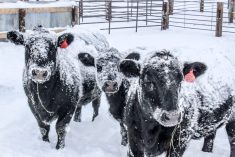Ottawa — Despite Prime Minister Justin Trudeau saying more money will be provided if needed, the agriculture sector continues to criticize Ottawa’s $252 million in COVID-19-related financial aid offered to producers and processors.
“If we have to add more, we will,” said Trudeau, after announcing new funding and programming.
The federal government is offering an additional $125 million to farmers through AgriRecovery, a disaster relief program forms part of its suite of business risk management (BRM) programs which deliver about $1.5 billion annually to farmers.
Read Also

Alberta crop conditions improve: report
Varied precipitation and warm temperatures were generally beneficial for crop development across Alberta during the week ended July 8, according to the latest provincial crop report released July 11.
Costs of the rarely used disaster support program are shared, with Ottawa paying 60 per cent and provinces paying 40 per cent. The program, which is usually triggered by provincial request, usually would pay 70 per cent of a farmer’s eligible expenses.
Federal Agriculture Minister Marie-Claude Bibeau said the federal government will raise the coverage level to 90 per cent for eligible expenses. As well, she said, the federal government is committed to providing the federal share of 60 per cent of the new rate, whether the provinces participate or not.
At least one of the provinces is not agreeing to increase its contributions, arguing the pandemic is a national issue and provinces are facing their own financial pressures.
“We are part and parcel to some of it, but definitely at the 60-40 (split) it makes it very difficult,” Saskatchewan’s Agriculture Minister Dave Marit said. “It’s clear the federal government has to come to the table with a bigger slice of the pie.”
Up to $50 million of the AgriRecovery funding is earmarked to fund a set-aside program for cattle producers, allowing them to keep their animals longer before marketing and help mitigate temporary closures of processing plants.
“From a beef industry viewpoint, it falls quite a bit short of what we need to maintain a thriving industry,” Canadian Cattlemen’s Association president Bob Lowe said. “Fifty million for set-aside, it’s definitely needed, it’s there, but unfortunately we used it up a number of weeks ago.”
Those comments were echoed by Michel Daigle, chair of the National Cattle Feeders’ Association, who said the $50 million, “is not significant enough to have an impact on this backlog or the additional costs of producers.”
According to Daigle, the backlog to the farm gate is up to 100,000 animals right now because of processing issues.
Pork producers will also receive $50 million of the AgriRecovery funds to help manage their herds.
In response, the Canadian Pork Council reiterated previous calls for funding equal to $20 per hog, a level it said would still not cover all losses. The council has estimated producers are losing $30 to $50 per finished hog, while weanling prices are “approaching zero.”
“Without an emergency aid for Canadian pork producers, family farms will be threatened, continue to be threatened, and the risk of the food supply disruption increases,” said chair Rick Bergmann, adding no details on how the funds will be used have been released.
Changes to another cost-shared program will allow producers in certain provinces to ask for an advance payment of 75 per cent under AgriStability, up 25 per cent from previous levels.
British Columbia, Quebec, Saskatchewan, Prince Edward Island and Alberta have all already agreed to the 75 per cent AgriStability interim payment.
“I’m still waiting on confirmation from some provinces and I will let them make the announcement whenever they are ready, so is this is the challenge with AgriStability, all of the provinces are not at the same place,” Bibeau said.
‘Rapidly evolving’
The federal government is also seeking an agreement with provinces under the AgriInsurance program to include labour shortages as an eligible expense for horticulture producers.
There are 11,200 temporary foreign workers in Canada right now, compared to about 13,000 at the same time last year, and there is continued concern not enough workers will be available for horticulture producers during harvest.
“I know provinces are right now having discussions with their administrators to see, to evaluate the financial impact it might have on each of them,” Bibeau said. “I think we are all trying to find ways to reassure horticulture, our fruit and vegetable producers, it’s one of their biggest challenges right now, to find labour and to ensure labour stays until the end of this season.”
Todd Lewis, president of the Agricultural Producers Association of Saskatchewan (APAS) and a Canadian Federation of Agriculture (CFA) board member, said the federal government is leaving provinces scrambling as it tries to address long-standing issues with BRM programming.
“I think it speaks to the weakness of current BRM programming. You need an agreement between the federal government and provinces,” he said. “It was never designed, any of this programming, to take into account and deal with something as rapidly evolving as COVID-19.”
Lewis joined a chorus of sector leaders who argued the federal funding fell well short of the $2.6 billion aid request made by the CFA.
“We are very mindful of many industries, many different sectors asking for help at this time and we don’t envy government in their position to have to make these decisions, but we stand by our position that second to health only should be food,” CFA president Mary Robinson said. “We need to ensure that our food supply system is secure and the foundation are Canadian farmers.”
The CFA’s ask included $500 million for beef and pork producers to deal with processing and supply chain disruptions and $1 billion for flower growers who have lost retail sales.
Grain Growers of Canada was quick to argue the relief package offered nothing for its members and failed to resolve long-standing issues with BRM programming, despite years-long conversations between producers and the government.
“It seems as if those conversations never really gained any traction,” GGC executive director Erin Gowriluk said.
To improve work conditions at processing facilities and producers, $77.5 million in federal funds will be used for the purchase of personal protective equipment.
The Canadian Dairy Commission, needing to deal with a milk surplus, will have access to an additional $200 million in borrowing capacity so that excess production can be used for cheese and butter, then stored until it is viable to sell.
“Never have we seen such fluctuation in demand for milk from one week to another, and despite the best efforts to manage production to align with consumer needs, bottlenecks resulted in milk having to be disposed at the farm, something no dairy farmer wants to see,” Pierre Lampron, president of Dairy Farmers of Canada, said in a statement.
While DFC acknowledged the funding fell short of the CFA’s proposed figure, the organization said it welcomes the federal measures, “which will help offset the impacts of bottlenecks in the supply chain that have prevented dairy from getting from the farm to the store shelf.”
DFC also hailed the AgriRecovery funding for a cattle set-aside, which it said would include dairy cull cows.
Also, through an additional $50 million fund, the federal government will purchase excess supplies of agrifood such as potatoes and poultry and distribute those to local organizations working to combat food insecurity.
The funding was celebrated by many in the agri-food sector, including McCain Foods.
“Over the recent weeks McCain, alongside potato farmers across the country, has been asking the government to participate in finding a solution for the large surplus of potatoes caused by the closure of restaurants due to coronavirus,” the potato processor’s CEO, Max Koeune, said in a statement.
“We are keen to see the details of the program, including timings. This support needs to be in place quickly, as potatoes in store are at risk of spoiling as the weather warms.”
— D.C. Fraser reports for Glacier FarmMedia from Ottawa.














